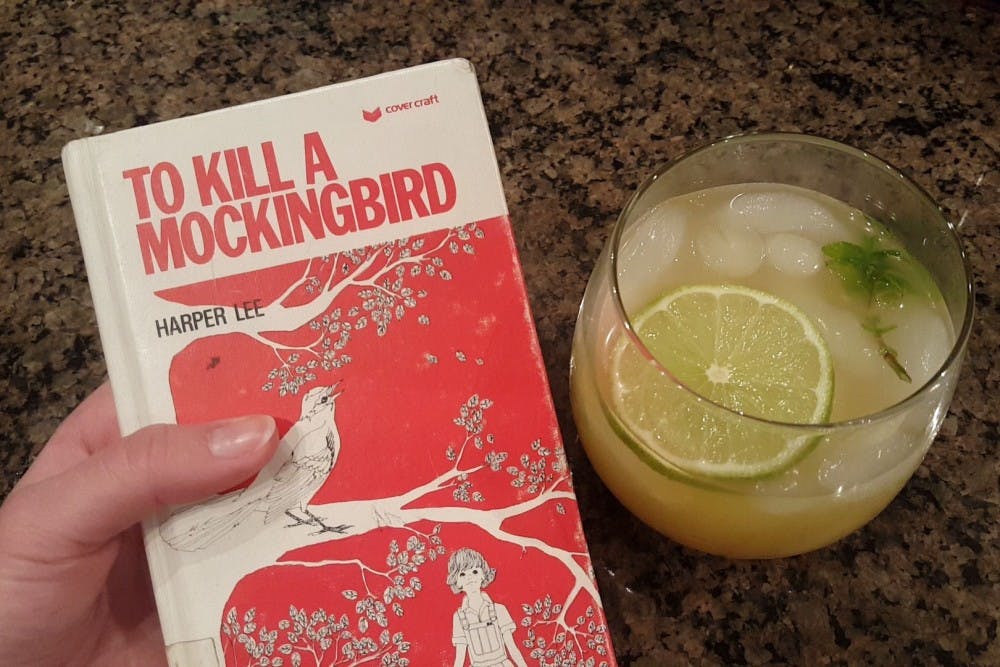Continuing a series started by former reporter and current digital editor Carson Abernethy in 2016, the arts and culture editors will drink their way through great works of literature, reviewing books and the booze that inspired them.
Written in 1960, Harper Lee’s classic Pulitzer Prize winning novel, “To Kill a Mockingbird,” was the only book Lee had written up until 2015 with the release of her second novel “Go Set a Watchman.” Lee passed away a year later on Feb. 19, 2016.
At its face value, “To Kill a Mockingbird” is a coming of age story told from the point of view of a young girl who is grappling with race, class and gender politics and society in Alabama during the Great Depression.
As a clever play on words, many compare the citrus tequila drink Tequila Mockingbird to the title of the book. Director and producer Lynn Rabren told Mobile Bay Magazine that he created a specific version of the drink on the day that actor Gregory Peck, who played Scout’s father Atticus Finch in the 1962 film adaption of “To Kill a Mockingbird,” died.
The drink is strong and refreshing, just like Scout is in the book.
Recipe:
2 oz. agave tequila
2 oz. freshly squeezed lime juice
1 tsp. agave syrup (or to taste)
3 oz. orange juice
1 whole mint sprig
"Combine tequila, lime juice and agave syrup in the bottom of a highball glass and stir until agave dissolves," according to the article in The Mobile Bay Magazine. "Fill the glass with ice and top with orange juice. Use mint sprig to stir."
Scout, who is only 6 years old, is extremely intelligent for her age, having been taught how to read by her father. Described as a tomboy and ridiculed by many in her town for it, Scout is learning to navigate the gender roles thrust upon her and the racial and social inequalities that her father Atticus is working to dismantle as a public defender.
Scout's experiences in the novel lead her to reevaluate her preconceived notions of the people around her and dismantle the prejudices embedded in the world around her.
Prose: 4.75/5
Lee’s writing in “To Kill a Mockingbird” is purposefully simple to exemplify the voice of 6-year-old Scout, which makes it an easy, fun read. Inversely, the content of her words is profound and insightful, making the book a perfect mix of meaningful and accessible to a wide audience, exemplary of Lee’s message of equality.
The meaning is revealed through themes and lines in the book, as Lee compares mockingbirds to innocent individuals who are unjustly judged and persecuted, summing it up as “mockingbirds don’t do one thing but make music for us to enjoy … that’s why it’s a sin to kill a mockingbird.”
Characterization: 5/5
The characters in the novel are an intricate ensemble of symbolism representing different aspects of society in the South during the 1930s. Scout represents the women’s movement of the decade and the value of education, her brother Jem, whose arm is broken, symbolizes the prejudices and brokenness of the American justice system.
Their father Atticus represents the parts of society that are decent and just, and he is called to defend Tom, a black man, who very literally represents the negative treatment of the African American community in the South at the time. Tom is being accused by Bob Ewell, who represents racism and patriarchy, of raping Ewell’s oldest daughter, who represents the oppression, victimization and helplessness of women in society.
Meanwhile, Boo Radley, recluse neighbor of Scout and her family, represents the poor and the overall misunderstandings of marginalized and minority groups in America. Through Scout's eyes, all of these characters and others are dismantled and evolve over the course of the novel.
Cohesiveness: 5/5
The novel flows well and reads quickly, and the sequence of events adequately follow Scout’s evolving view of society and the people around her.
Relevance: 5/5
Although set in the 30s, “To Kill a Mockingbird” is as relevant today as it ever was. The themes in the book teach the audience to imagine the perspectives of others and emphasizes the classic adage of not judging a book by its cover. As Atticus puts it, "you never really understand a person until you consider things from his point of view – until you climb into his skin and walk around in it.” In today's political climate it's important for people to try and understand where others are coming from and challenge their own preconceived notions, as 6-year-old Scout does in the novel.
Overall: 5/5
"To Kill a Mockingbird" is a perfect allegory for racial, social and gender inequality in America, and Lee eloquently dismantles prejudices in a novel that readers of all ages can enjoy and learn from. The novel is a striking, timeless commentary on society, and continues to be a beloved favorite for generations of readers.
Read more: Books & Booze: 'The Great Gatsby' by F. Scott Fitzgerald
Reach the reporter at abpotter@asu.edu and follow @lexipotter04 on Twitter.
Like The State Press on Facebook and follow @statepress on Twitter.




